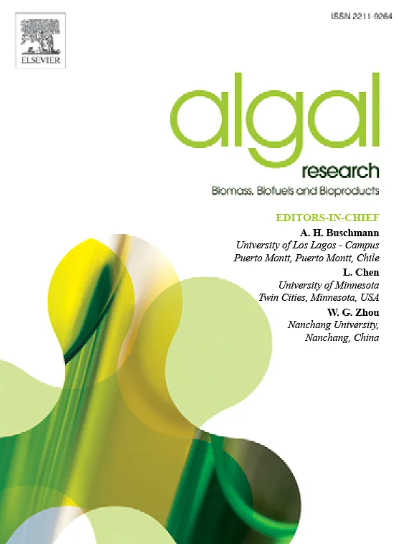生物勘探微藻菌株在ph调节下使用碳酸氢盐培养以提高碳捕获和利用
IF 4.6
2区 生物学
Q1 BIOTECHNOLOGY & APPLIED MICROBIOLOGY
Algal Research-Biomass Biofuels and Bioproducts
Pub Date : 2025-04-23
DOI:10.1016/j.algal.2025.104064
引用次数: 0
摘要
微藻作为生物燃料生产的可持续资源具有巨大的潜力。然而,由于传质效率差,气态CO2的低效率供应可能导致碳限制,这对大规模微藻培养提出了重大挑战。本研究探讨了以pH-stat碳酸氢盐为基础的各种微藻菌株的碳水化合物和脂质生产。对四种绿藻菌株利用碳酸氢盐离子作为无机碳源进行光合作用的能力进行了评价。其中,Chlamydomonas sp. JSC4在50 mM KHCO3、pH 8和培养7 d的条件下,生物量浓度(1.05±0.05 g/L)、生物量生产力(242 mg/L/d)、脂质含量(42.7±0.85%)和碳水化合物含量(39.16±0.09%)最高。本研究获得的生物量生产力高于文献报道。所有菌株的预测生物柴油质量均符合ASTM D6751和EN 14214规范。将碳酸氢盐浓度提高到100 mM,采用补料批培养模式,生物量达到1.45±0.32 g/L,碳水化合物积累达到58.25±1.28% DCW,固碳效率达到63.8±3.23%,显著高于CO2供应对照(0.30±0.04%)。本研究强调了补充碳酸氢盐离子作为一种有效的策略的潜力,可以最大限度地生产具有高生产力和生物分子积累的生物质,有助于实现具有成本效益的微藻生物燃料生产。本文章由计算机程序翻译,如有差异,请以英文原文为准。

Bioprospecting microalgal strains cultivated using bicarbonate under a pH-regulated regime for enhanced carbon capture and utilization
Microalgae offers significant potential as a sustainable resource for biofuel production. However, an inefficient supply of gaseous CO2 can lead to carbon limitation due to poor mass transfer efficiency, which poses a significant challenge in large-scale microalgal cultures. This study investigates pH-stat bicarbonate-based cultivation of various microalgal strains aimed at carbohydrate and lipid production. Four green algal strains were assessed for their capability to utilize bicarbonate ions as their inorganic carbon source for photosynthesis. Among the strains, Chlamydomonas sp. JSC4 attained the highest biomass concentration (1.05 ± 0.05 g/L), biomass productivity (242 mg/L/day), lipid content (42.7 ± 0.85 %), and carbohydrate content (39.16 ± 0.09 %) under conditions of 50 mM KHCO3, pH 8, and 7 days of cultivation. The biomass productivity attained in this study is higher than those in the reported literature. The predicted biodiesel quality for all strains met the ASTM D6751 and EN 14214 specifications. Increasing the bicarbonate concentration to 100 mM and employing a fed-batch mode elevated the biomass to 1.45 ± 0.32 g/L, carbohydrate accumulation to 58.25 ± 1.28 % DCW, and carbon fixation efficiency to 63.8 ± 3.23 %, which is significantly higher than that of the control cultivated with CO2 supply (0.30 ± 0.04 %). This study highlights the potential of bicarbonate ion supplementation as an effective strategy for maximal biomass production with high productivity and biomolecule accumulation, aiding in the realization of cost-effective microalgal biofuel production.
求助全文
通过发布文献求助,成功后即可免费获取论文全文。
去求助
来源期刊

Algal Research-Biomass Biofuels and Bioproducts
BIOTECHNOLOGY & APPLIED MICROBIOLOGY-
CiteScore
9.40
自引率
7.80%
发文量
332
期刊介绍:
Algal Research is an international phycology journal covering all areas of emerging technologies in algae biology, biomass production, cultivation, harvesting, extraction, bioproducts, biorefinery, engineering, and econometrics. Algae is defined to include cyanobacteria, microalgae, and protists and symbionts of interest in biotechnology. The journal publishes original research and reviews for the following scope: algal biology, including but not exclusive to: phylogeny, biodiversity, molecular traits, metabolic regulation, and genetic engineering, algal cultivation, e.g. phototrophic systems, heterotrophic systems, and mixotrophic systems, algal harvesting and extraction systems, biotechnology to convert algal biomass and components into biofuels and bioproducts, e.g., nutraceuticals, pharmaceuticals, animal feed, plastics, etc. algal products and their economic assessment
 求助内容:
求助内容: 应助结果提醒方式:
应助结果提醒方式:


